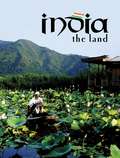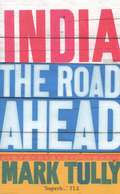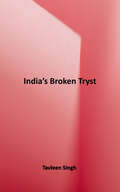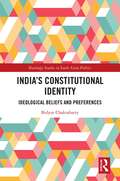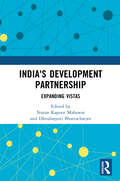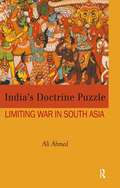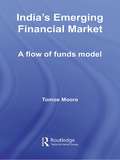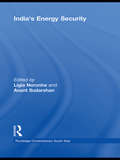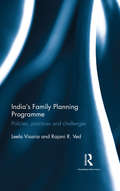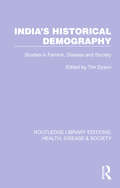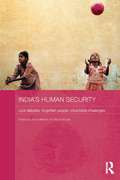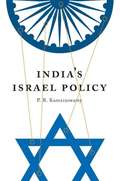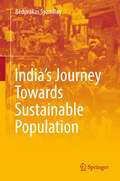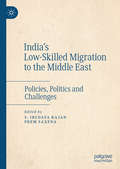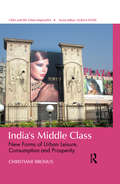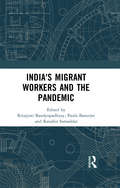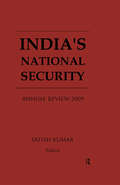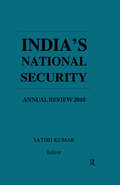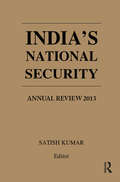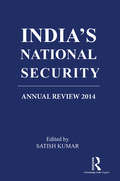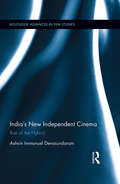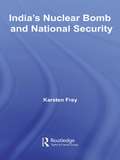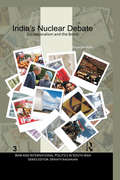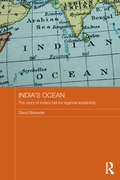- Table View
- List View
India of My Dreams
by M. K. GandhiIt is a happy idea to place before the world and the country at the present moment when we are entering upon a new era a picture of the India of Mahatma Gandhi’s dreams. The freedom which we have won is throwing upon us the responsibilities of making or marring the future of India. It is in no small measure the achievement of Mahatma Gandhi’s leadership. The matchless weapon of truth and non-violence which he has used is needed by the world to cure it of many of its ills. In our hour of victory and rejoicings we cannot afford to ignore either the leader who has led us or the undying principles which have inspired him. Freedom is only the means to a greater and nobler end, and the achievement of India of Mahatma Gandhi’s dreams will be the fitting consummation of all that he has worked for and stands for. A book, which places before the reader not only those basic and fundamental principles, but also indicates how we can help to fulfil them through our freedom by establishing a polity and social life, and through the instrumentality of a constitution and the dedication of the human material which this vast country will now throw up to work without any external fetters or internal inhibitions. — Rajendra Prasad
India the Land (Lands, Peoples, and Cultures)
by Bobbie KalmanUpdated facts and statistics highlight this new second revised edition of India the Land. Spectacular photographs feature India's varied geography from snow-covered mountaintops to tropical rainforests. Learn about India's major cities, its disputed borders, foreign influences, and current challenges
India the Road Ahead
by Mark TullyFull of fascinating stories of real people at a time of great change, it will be of interest to economists, business people, diplomats, politicians, as well as to those who love to travel and who take an interest in the rapid growth of one of the world's largest countries, and what this means to us in the West.
India's Broken Tryst
by Tavleen SinghSeventy years after Nehru’s beautiful midnight speech – ‘Long years ago we made a tryst with destiny…’ – in Indian cities and villages millions survive on less than the bare minimum. Children are not in classrooms, women have nowhere safe to relieve themselves, and jobless men lie around in a daze. In cities, where initiative should flourish, a merciless state looms large over every common endeavour. The civilization that was India, that grand culture, has not found utterance again. Long years after freedom from the British, why do we remain suppressed? In India’s Broken Tryst, bestselling author and popular political columnist Tavleen Singh chronicles the damage done. Here is the story of Surekha, who lives on the pavements of Mumbai’s landmark Marine Drive with memories of crushing hunger. Of Ali, the idli seller who is forced out of his honest livelihood by cops and corporators. Of Sahib and Sardar, little boys torn from their mother on the criminal charge of begging. Of those nameless servants who do not have access to toilets even as they service the luxury apartments where Singh lives. From the very poor to the very rich, Tavleen Singh catalogues in bold, eviscerating detail the systematic unmaking of our sense of destiny. Can an Indian dream stretch beyond food and water, literacy, toilets, and in some cases just a document of identification? If not, what destiny?
India's Constitutional Identity: ideological beliefs and preferences (Routledge Studies in South Asian Politics)
by Bidyut ChakrabartyAn analysis of selective aspects of India’s constitutional identity, this book provides an analytical account of the changing and changed texture of India’s constitutional identity bearing in mind the historical context in which it is articulated. The book conceptualizes the gradual evolution of an idea by tracing the history of India’s constitutionalism with reference to its conceptual roots, historical antecedents and the landmark judicial pronouncements in which the concern for its retention and protection is always privileged. The author examines specific constitutional designs that the 1950 Constitution of India put in place and argues that constitutional identity, despite being drawn on specific constitutional provisions, is also changeable in view of the rapidly transforming socio-economic milieu. He demonstrates that there are numerous instances where India’s constitutional identity has undergone a metamorphosis in circumstances where newer politico-ideological values and norms are privileged. A valuable addition to the literature on constitutionalism and constitutional practices in general and their manifestation in India's democratic experiences, in particular, this book will be of interest to academics in the fields of Government, Political Science, Law and Jurisprudence, Constitutional and Legal History and Asian Studies.
India's Development Partnership: Expanding Vistas
by Nutan Kapoor Mahawar Dhrubajyoti BhattacharjeeIndia's foreign policy is based on the principle of "Vasudhaiva Kutumbakam"—the world is one family. Despite resource constraints, India shares its developmental experience and technical expertise with other developing countries as part of its commitment to South-South cooperation. India's development partnership is a mutually beneficial human-centric model based on trust, respect, sovereignty, transparency, and collaboration. This edited volume compiles views and papers presented at a seminar on India's Development Partnership, marking ten years of the Development Partnership Administration.Print edition not for sale in South Asia (India, Sri Lanka, Nepal, Bangladesh, Pakistan and Bhutan)
India's Doctrine Puzzle: Limiting War in South Asia
by Ali AhmedThe balance of power in South Asia is tenuous. Neighbouring states with nuclear arsenal pose a serious threat in times of conflict and the danger of escalation into a nuclear holocaust in South are ever-present. This book locates the change in India’s war doctrine at the turn of the century, following the Kargil War in 1999 between India and Pakistan. It examines how war policy was shaped by the threat posed by India’s neighbours and the need for greater strategic assertion. It also reveals that this change was forced by the military’s need to adapt itself to the nuclear age. Finally, it raises questions of whether the Limited War doctrine has made India more secure. An astute analysis of not only India’s military strategy but also of military doctrine in general, this book will be valuable to scholars and researchers of defence and strategic studies, international relations, peace and conflict studies, South Asia studies as well as government and military institutions.
India's Emerging Financial Market: A Flow of Funds Model (Routledge Studies in the Growth Economies of Asia #Vol. 77)
by Tomoe MooreIn the early 1990s, financial liberalization started in India, and it was thought that such reforms would increase economic growth. This argument formed part of the finance led industrialization hypothesis and although higher growth resulted, higher industrialization did not immediately. This book is the first study to comprehensively apply the flow of funds model for India. Using detailed data of the Indian economy, the whole financial sector is presented with associated policy simulation for India. The demand function is theoretically grounded in the Almost Ideal Demand System and cointegration techniques are adapted into the econometric methodology. The policy simulation experiments are conducted with a view to analyzing the delivery of loanable funds to sectors which are the most in need of poverty-reducing economic growth. The system-wide simulation as a result of interactions with disaggregated economic sectors will allow the analysis of a wide spectrum of policy effects on issues such as the determinant of interest rates, financial capital formulation, and the role of financial institutions, government debt and allocation of credit. India's Emerging Financial Market provides a thorough and rigorous analysis of policy responses in India and will be of interest to academics working on development economics in general and South Asia in particular.
India's Energy Security (Routledge Contemporary South Asia Series)
by Ligia Noronha Anant SudarshanThis book explores the multifaceted aspects of India’s energy security concerns. Bringing together a set of opinions and analysis from experts and policymakers, it sheds light on the context of India’s energy insecurity and explores its various dimensions, its nature and extent. Contributors examine the role that trade, foreign and security policy should play in enhancing India’s energy security. It is argued that the key challenge for India is to increase economic growth while at the same time keeping energy demands low. This is especially challenging with the transition from biomass to fossil fuels, the growth of motorized private transport, and rising incomes, aspirations and changing lifestyles. The book suggests that at this time there are strong arguments to lessen the fossil fuel path dependence and it argues for a need to engage with all the key sources of this dependence to implement a process of energy change. India’s Energy Security is a timely contribution given the national and international interest in the issue of energy security and the possibility that energy concerns have the potential of becoming the cause of serious international conflicts. It will be of interest to academics and policy makers working in the field of Asian Studies, Energy Policy, International Relations and Security Studies.
India's Family Planning Programme: Policies, practices and challenges
by Leela Visaria Rajani R. VedThis book closely examines the changes, challenges and shifts in India’s family planning programme since its inception in 1952. It discusses the dynamics of population growth, the demographic dividend, family planning and its impact on maternal and child health, and the pressures from various quarters to remove method-specific contraceptive targets from the programme. The volume highlights the shortcomings in the delivery of services by the public sector and the critical role of non-government organisations in research, promotion and advocacy. Rich in empirical data, this book will be an indispensable resource for scholars, policymakers, organisations and NGOs concerned with population and demographic studies. It will also interest those in sociology, public policy and public health.
India's Historical Demography: Studies in Famine, Disease and Society (Routledge Library Editions: Health, Disease and Society #12)
by Tim DysonWhen this book was originally published in 1989 here had been virtually no studies of the country’s historical demography. This volume was significant for 3 reasons: it contributed greatly to the knowledge of India’s population history; it had major implications for the work of social and economic historians of India; and lastly the Indian context provides an excellent laboratory in which to investigate certain large-scale demographic phenomena – among others the experience of bubonic plague, influenza, cholera and famine.
India's Human Security: Lost Debates, Forgotten People, Intractable Challenges (Routledge Studies in South Asian Politics)
by Åshild Kolås Jason MiklianIndia's explosive economic growth and emerging power status make it a key country of interest for policymakers, researchers and scholars within South Asia and around the world. But while many of India's threats and conflicts are strategized and discussed extensively within the confines of security studies, strategic studies and conventional international relations perspectives, many less visible challenges are set to impact significantly on India's potential for economic growth as well as the human security and livelihoods of hundreds of millions of Indian citizens. Drawing on extensive research within India, this book looks at some of the ‘hidden risks’ that India faces, exploring how a broadened scope of what constitutes ‘risk’ itself holds value for Indian security studies practitioners and policymakers. It highlights several human security risks facing India, including the inability of the world’s largest democracy to deal effectively with widespread poverty and health issues, resource depletion and environmental mismanagement, pervasive corruption and institutionalized crime, communal violence, a protracted Maoist insurgency, and deadlocked peace processes in the Northeast among others. The book extracts common themes from these seemingly disparate problems, discussing what underlying failures allow them to persist and why policymakers heavily securitize some political issues while ignoring others. Providing an understanding of how several lesser-studied risks can pose potential or actual threats to Indian society and its ‘emerging power’ growth narrative, this book is a useful contribution to South Asian Studies, International Security Studies and Global Politics.
India's Israel Policy
by P. R. KumaraswamyIndia's foreign policy toward Israel is a subject of deep dispute. Throughout the twentieth century arguments have raged over the Palestinian problem and the future of bilateral relations. Yet no text comprehensively looks at the attitudes and policies of India toward Israel, especially their development in conjunction with history.P. R. Kumaraswamy is the first to account for India's Israel policy, revealing surprising inconsistencies in positions taken by the country's leaders, such as Mahatma Gandhi and Jawaharlal Nehru, and tracing the crackling tensions between its professed values and realpolitik. Kumaraswamy's findings debunk the belief that India possesses a homogenous policy toward the Middle East. In fact, since the early days of independence, many within India have supported and pursued relations with Israel. Using material derived from archives in both India and Israel, Kumaraswamy investigates the factors that have hindered relations between these two countries despite their numerous commonalities. He also considers how India destabilized relations, the actions that were necessary for normalization to occur, and the directions bilateral relations may take in the future. In his most provocative argument, Kumaraswamy underscores the disproportionate affect of anticolonial sentiments and the Muslim minority on shaping Indian policy.
India's Journey Towards Sustainable Population
by Bedprakas SyamroyThis book makes a thorough investigation of the population problem issues in India from diverse angles- demographic, policy and programme. Discussing the theoretical background of population control, the book also deals with all mundane issues - social, cultural, religious, legal and health issues, and attempts to capture the state of preparedness of India to reach sustainable population. It is a valuable resource for students of population studies and academics working on population control and management. Additionally, it is also a useful reference work for trainees at national academies, journalists, family welfare service providers and the civil society groups working on population control and family planning.
India's Low-Skilled Migration to the Middle East: Policies, Politics and Challenges
by S. Irudaya Rajan Prem SaxenaThis book provides new insights and research studies on how developing countries come to terms with the nationalisation policies of Gulf economies that provide employment for their nationals. Focusing on regions and countries that have traditionally been overlooked, it includes studies on labour migration from Egypt to the Middle East and from the Philippines to Lebanon, migrant experiences and policy prospects in Saudi Arabia and Lebanon, and Indian migration to the Gulf. The book fills a critical gap in migration research by studying migration from various Indian states, such as Tamil Nadu, Telugu-speaking states (Telangana and Andhra Pradesh), Rajasthan and Uttar Pradesh. It also explores the unexpected phenomenon of demographic windows of economic opportunity (not documented in demographic literature) observed in a few Arab countries due to older migrant expatriates returning to their home country; the impact of international out-migration on intergenerational educational mobility among children in migrant-sending households in Kerala; and forced migration of Kerala Muslims to the Gulf.
India's Middle Class: New Forms of Urban Leisure, Consumption and Prosperity (Cities and the Urban Imperative)
by Christiane BrosiusThis book examines the complexities of lifestyles of the upwardly mobile middle classes in India in the context of economic liberalisation in the new millennium, by analysing new social formations and aspirations, modes of consumption and ways of being in contemporary urban India. Rich in ethnographic material, the work is based on empirical case-studies, research material, and illustrations. Offering a model of how urban cosmopolitan India might be studied and understood in a transnational and transcultural context, the book takes the reader through three panoramic landscapes: new ‘world-class’ real estate advertising, a unique religious leisure site — the Akshardham Cultural Complex, and the world of themed weddings and beauty/wellness, all responses to India’s new middle classes’ tryst with cosmopolitanism. The work will be of particular interest to scholars and researchers in sociology, South Asian studies, media studies, anthropology and urban studies as also those interested in religion, performance and rituals, diaspora, globalisation and transnational migration.
India's Migrant Workers and the Pandemic
by Ranabir Samaddar Paula Banerjee Ritajyoti BandyopadhyayA sudden announcement was made by the government on 24 March 2020 of a complete lockdown of the country, due to the spectre of Coronavirus. India’s Migrant Workers and the Pandemic was being written as the crisis was unfolding with no end in sight. Migrant workers from different parts of India had no choice but to trek back hundreds of kilometres carrying their scanty belongings and dragging their hungry and thirsty children in the scorching heat of the plains of India to reach home. How did caste, race, gender, and other fault lines operate in this governmental strategy to cope with a virus epidemic?The eight papers in this collection, highlight the ethical and political implications of the epidemic—particularly for India’s migrant workers. What were the forces of power at play in this war against the epidemic? What measures could have been taken and need to be taken now? Please note: Taylor & Francis does not sell or distribute the Hardback in India, Pakistan, Nepal, Bhutan, Bangladesh and Sri Lanka.
India's National Security: Annual Review 2009
by Satish KumarEach year, this annual gives readers an in-depth and up-to-date account of India’s external and internal threats in a deteriorating global security environment. It shows that while partnerships with some countries have strengthened, anxieties persist with others such as China and Pakistan. Similarly, India has not been able to cope with the challenges of internal security emerging from violence in Kashmir, insurgency in the northeast, to mention a few. A unique series with contributions from academics, political commentators and military personnel.
India's National Security: Annual Review 2010
by Satish KumarThis book gives readers an in-depth and up-to-date account of India’s external and internal threats in a deteriorating global security environment. It shows that while partnerships with some countries have strengthened, anxieties persist with others such as China and Pakistan. Similarly, India has not been able to cope with the challenges of internal security emerging from violence in Kashmir, insurgency in the north-east, to mention a few. Problems of global terrorism and global warming stare us in the face. Tensions between major powers, threats and counter-threats between major and middle powers, and international hotspots like Georgia and Afghanistan remind us that there is intense competition for strategic space. India as an upcoming power is treading its path carefully and is developing meaningful partnerships with all major powers. China’s reluctance to proceed further in resolving the boundary dispute with India, its reported incursions on the borders and its rapid military modernisation has caused anxiety in India. India is nevertheless upgrading its military capability to meet any Chinese threat. Pakistan’s lack of adequate action in punishing those responsible for the 26/11 Mumbai terrorist attack and its reluctance to destroy the infrastructure of terrorism in Pakistan has put a question mark on the future of India Pakistan relations. These and various other threats and challenges are discussed in this volume, latest in a unique series with contributions from academics, political commentators and military personnel.
India's National Security: Annual Review 2013
by Satish KumarIndia’s National Security: Annual Review 2013 comprehensively analyses India’s engagement with major world powers, and immediate neighbours in a complex global security environment. It examines India’s response to internal and external threats, its foreign policy as well as measures taken for strengthening its economic security.
India's National Security: Annual Review 2014
by Satish KumarThis fourteenth volume of India’s National Security Annual Review intensively analyses India’s national security with respect to the changing internal and external dynamics. In the global environment, the situation is characterised by rising tensions between United States and Russia, intensified rivalry between United States (US) and China, and increasing cooperation between China and Russia. For India which seeks peaceful growth to emerge as a major power, this poses severe diplomatic challenges. This volume discusses the complexity of these challenges and the deftness with which India gets the best out of its strategic partnerships with the US and Russia while warding off the transgressions of a mighty adversary like China. It also studies the impact of internal convulsions and external intrusions on India’s security from South Asian nations such as Afghanistan, Bangladesh, Nepal and Sri Lanka. Examining the field of internal security, the essays carry rare insights into the causes of expansion of Naxalite violence in tribal areas and the dynamics of conflict resolution in the Northeast, as well as India’s deep concern as a growing power with its economic slowdown in the recent past, and energy and cyber security. Bringing together contributions from eminent scholars and diplomats, the volume will be indispensable for policymakers, government think tanks, defence and strategic studies experts, as well as students and researchers of international relations, foreign policy and political science.
India's New Independent Cinema: Rise of the Hybrid (Routledge Advances in Film Studies)
by Ashvin Immanuel DevasundaramThis is the first-ever book on the rise of the new wave of independent Indian films that is revolutionising Indian cinema. Contemporary scholarship on Indian cinema so far has focused asymmetrically on Bollywood—India’s dominant cultural export. Reversing this trend, this book provides an in-depth examination of the burgeoning independent Indian film sector. It locates the new 'Indies' as a glocal hybrid film form—global in aesthetic and local in content. They critically engage with a diverse socio-political spectrum of ‘state of the nation’ stories; from farmer suicides, disenfranchised urban youth and migrant workers to monks turned anti-corporation animal rights agitators. This book provides comprehensive analyses of definitive Indie new wave films including Peepli Live (2010), Dhobi Ghat (2010), The Lunchbox (2013) and Ship of Theseus (2013). It explores how subversive Indies, such as polemical postmodern rap-musical Gandu (2010) transgress conventional notions of ‘traditional Indian values’, and collide with state censorship regulations. This timely and pioneering analysis shows how the new Indies have emerged from a middle space between India’s globalising present and traditional past. This book draws on in-depth interviews with directors, actors, academics and members of the Indian censor board, and is essential reading for anyone seeking an insight into a current Indian film phenomenon that could chart the future of Indian cinema.
India's Nuclear Bomb and National Security (Routledge Advances in South Asian Studies #Vol. 4)
by Karsten FreyIndia’s Nuclear Bomb and National Security gives an analytic account of the dynamics of India's nuclear build up. It puts forward a new comprehensive model, which goes beyond the classic strategic model of accepting motives of arming behaviour, and incorporates the dynamics in India’s nuclear programme. The core argument of the book surrounds the question about India's security considerations and their impact on India's nuclear policy development. Karsten Frey explores this analytic model by including explanatory variables on the unit-level, where interests are generally related to symbolic, less strategic values attributed to nuclear weapons. These play a significant role within India's domestic political party competition and among certain pressure groups. They also impacted India's relationship with other countries on non-proliferation matters, for example the concept of the country's 'status' and 'prestige'. Identifying the role of the strategic elite in determining India's nuclear course, this book also argues that one of the pivotal driving forces behind India's quest for the nuclear bomb is India's struggle for international recognition and the strong, often obsessive sensitivities of India's elite regarding 'acts of discrimination' or 'ignorance' by the West towards India.
India's Nuclear Debate: Exceptionalism and the Bomb (War and International Politics in South Asia)
by Priyanjali MalikMaking the right-wing Bharatiya Janata Party’s nuclear tests in 1998 its starting point, this book examines how opinion amongst India’s ‘attentive’ public shifted from supporting nuclear abstinence to accepting — and even feeling a need for — a more assertive policy, by examining the complexities of the debate in India on nuclear policy in the 1990s. The study seeks to account for the shift in opinion by looking at the parallel processes of how nuclear policy became an important part of the public discourse in India, and what it came to symbolise for the country’s intelligentsia during this decade. It argues that the pressure on New Delhi in the early 1990s to fall in line with the non-proliferation regime, magnified by India’s declining global influence at the time, caused the issue to cease being one of defence, making it a focus of nationalist pride instead. The country’s nuclear programme thus emerged as a test of its ability to withstand external compulsions, guaranteeing not so much the sanctity of its borders as a certain political idea of it — that of a modern, scientific and, most importantly, ‘sovereign’ state able to defend its policies and set its goals.
India's Ocean: The Story of India's Bid for Regional Leadership (Routledge Security in Asia Pacific Series)
by David BrewsterThis book assesses India’s role as a major power in the Indian Ocean. Many see the Indian Ocean as naturally falling within India’s sphere of influence but, as this book demonstrates, India has a long way to go before it could achieve regional dominance. The book outlines the development of Indian thinking on its role in the Indian Ocean and examines India’s strategic relationships in the region, including with maritime South Asia, the Indian Ocean islands, East Africa, the Middle East, Southeast Asia and Australia. The book then discusses India’s ambivalent relationship with the United States and explores its attitude towards China’s growing power in the Indian Ocean. It concludes by discussing the region’s evolving strategic order – does India have what it takes to become the leading power in the region?

